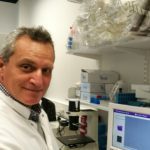Link to Pubmed [PMID] – 16434037
Exp. Neurol. 2006 Mar;198(1):167-82
In contrast to mouse embryonic stem cells and in spite of overlapping gene expression profiles, neural stem cells (NSCs) isolated from the embryonic spinal cord do not respond to physiological morphogenetic stimuli provided by Sonic hedgehog and retinoic acid and do not generate motor neurons upon differentiation. Transcription factors expressed in motor neuron progenitors during embryogenesis include Pax6, Ngn2, Nkx6.1 and Olig2, whose expression precedes that of factors specifying motor neuron fate, including HB9, Islet1 and LIM3. We showed that all these factors were present in neural progenitors derived from mouse ES cells, whereas NSCs derived from the rat embryonic spinal cord expressed neither HB9 nor Islet1 and contained low levels of Nkx6.1 and LIM3. We constructed a lentivirus vector to express HB9 and GFP in NSCs and examined the consequences of HB9 expression on other transcription factors and cell differentiation. Compared to cell expressing GFP alone, NSCs expressing GFP and HB9 cycled less rapidly, downregulated Pax6 and Ngn2 mRNA levels, produced higher proportions of neurons in vitro and lower numbers of neurons after transplantation in the spinal cord of recipient rats. Oligodendrocytic and astrocytic differentiations were not affected. HB9 expressing NSCs did not express Islet1 or upregulate LIM3. They neither responded to Sonic hedgehog and retinoic acid nor produced cholinergic neurons. We concluded that forced HB9 expression affected neurogenesis but was not sufficient to confer motor neuron fate to NSCs.


